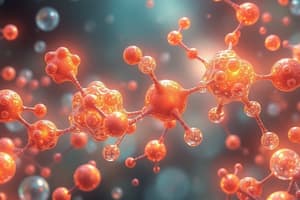Podcast
Questions and Answers
What are the two types of biochemical substances mentioned in the text?
What are the two types of biochemical substances mentioned in the text?
- Bioinorganic substances and proteins
- Bioinorganic substances and bioorganic substances (correct)
- Carbohydrates and water
- Lipids and nucleic acids
What is the general function of structural polysaccharides?
What is the general function of structural polysaccharides?
- Enzyme regulation
- Energy storage
- Cell recognition
- Structural support (correct)
Which classification of carbohydrates is based on chirality and handedness in molecules?
Which classification of carbohydrates is based on chirality and handedness in molecules?
- Glycolipids
- Polysaccharides
- Monosaccharides (correct)
- Disaccharides
In the context of carbohydrates, what is chirality associated with?
In the context of carbohydrates, what is chirality associated with?
Which type of carbohydrates are used for cell recognition purposes?
Which type of carbohydrates are used for cell recognition purposes?
What distinguishes enantiomers from diastereomers in terms of molecular structure?
What distinguishes enantiomers from diastereomers in terms of molecular structure?
What is the main function of carbohydrate oxidation in the human body?
What is the main function of carbohydrate oxidation in the human body?
Which of the following is a common short-term energy reserve provided by carbohydrates?
Which of the following is a common short-term energy reserve provided by carbohydrates?
What role do carbohydrates play in supplying carbon atoms for the synthesis of biochemical substances?
What role do carbohydrates play in supplying carbon atoms for the synthesis of biochemical substances?
Which type of carbohydrates are structural components of cell membranes?
Which type of carbohydrates are structural components of cell membranes?
In the context of carbohydrates, what does chirality refer to?
In the context of carbohydrates, what does chirality refer to?
Based on the simpler formula Cn(H2O)n, what does n represent when referring to carbohydrates?
Based on the simpler formula Cn(H2O)n, what does n represent when referring to carbohydrates?
Which type of carbohydrate contains ~2-10 monosaccharide units covalently bonded to each other?
Which type of carbohydrate contains ~2-10 monosaccharide units covalently bonded to each other?
What is the general characteristic of monosaccharides?
What is the general characteristic of monosaccharides?
Which carbohydrate is commonly found in paper, cotton, and wood?
Which carbohydrate is commonly found in paper, cotton, and wood?
What is the main function of disaccharides in the human body?
What is the main function of disaccharides in the human body?
How many carbon atoms are common in monosaccharides according to the given text?
How many carbon atoms are common in monosaccharides according to the given text?
What is the main characteristic of polymers in the context of carbohydrates?
What is the main characteristic of polymers in the context of carbohydrates?
Flashcards are hidden until you start studying
Study Notes
Types of Biochemical Substances
- Two primary types of biochemical substances are carbohydrates and lipids.
Function of Structural Polysaccharides
- Structural polysaccharides provide support and protection to cells and organisms, contributing to cellular structure.
Classification of Carbohydrates
- Carbohydrates can be classified based on chirality and handedness in molecules, specifically into enantiomers.
Chirality in Carbohydrates
- Chirality in carbohydrates is associated with the spatial arrangement of atoms in a molecule, leading to distinct mirror-image forms.
Carbohydrates for Cell Recognition
- Glycoconjugates, which include glycoproteins and glycolipids, are carbohydrates used for cell recognition and signaling purposes.
Enantiomers vs. Diastereomers
- Enantiomers are mirror images of each other, while diastereomers have different configurations at one or more but not all chiral centers, leading to distinct molecular structures.
Function of Carbohydrate Oxidation
- Carbohydrate oxidation primarily provides energy through the breakdown of carbohydrates into usable energy forms.
Short-term Energy Reserve
- Glycogen serves as a common short-term energy reserve provided by carbohydrates, stored mainly in liver and muscle tissues.
Carbon Supply from Carbohydrates
- Carbohydrates supply carbon atoms essential for the synthesis of various biochemical substances, including amino acids and nucleotides.
Structural Carbohydrates in Membranes
- Glycolipids and glycoproteins function as structural components of cell membranes, playing roles in membrane stability and cell signaling.
Chirality Definition
- In carbohydrates, chirality refers to the property of a molecule having non-superimposable mirror images.
Value of n in Carbohydrates
- In the general formula Cn(H2O)n for carbohydrates, 'n' represents the number of carbon atoms in the molecule.
Oligosaccharides
- Oligosaccharides consist of approximately 2-10 monosaccharide units covalently bonded to form a larger carbohydrate structure.
Characteristics of Monosaccharides
- Monosaccharides are the simplest form of carbohydrates, characterized by being single sugar units that serve as the building blocks for larger carbohydrates.
Carbohydrate Found in Paper, Cotton, and Wood
- Cellulose, a polysaccharide, is commonly found in paper, cotton, and wood, contributing to their structural integrity.
Function of Disaccharides
- Disaccharides primarily function as energy sources, providing quick energy upon hydrolysis into monosaccharides.
Common Carbon Atoms in Monosaccharides
- Monosaccharides typically contain three to seven carbon atoms, with five and six carbon atoms being the most common.
Polymers in Carbohydrates
- Polymers of carbohydrates are characterized by their large molecular structures formed by the repetition of monosaccharide units, creating complex carbohydrates.
Studying That Suits You
Use AI to generate personalized quizzes and flashcards to suit your learning preferences.




